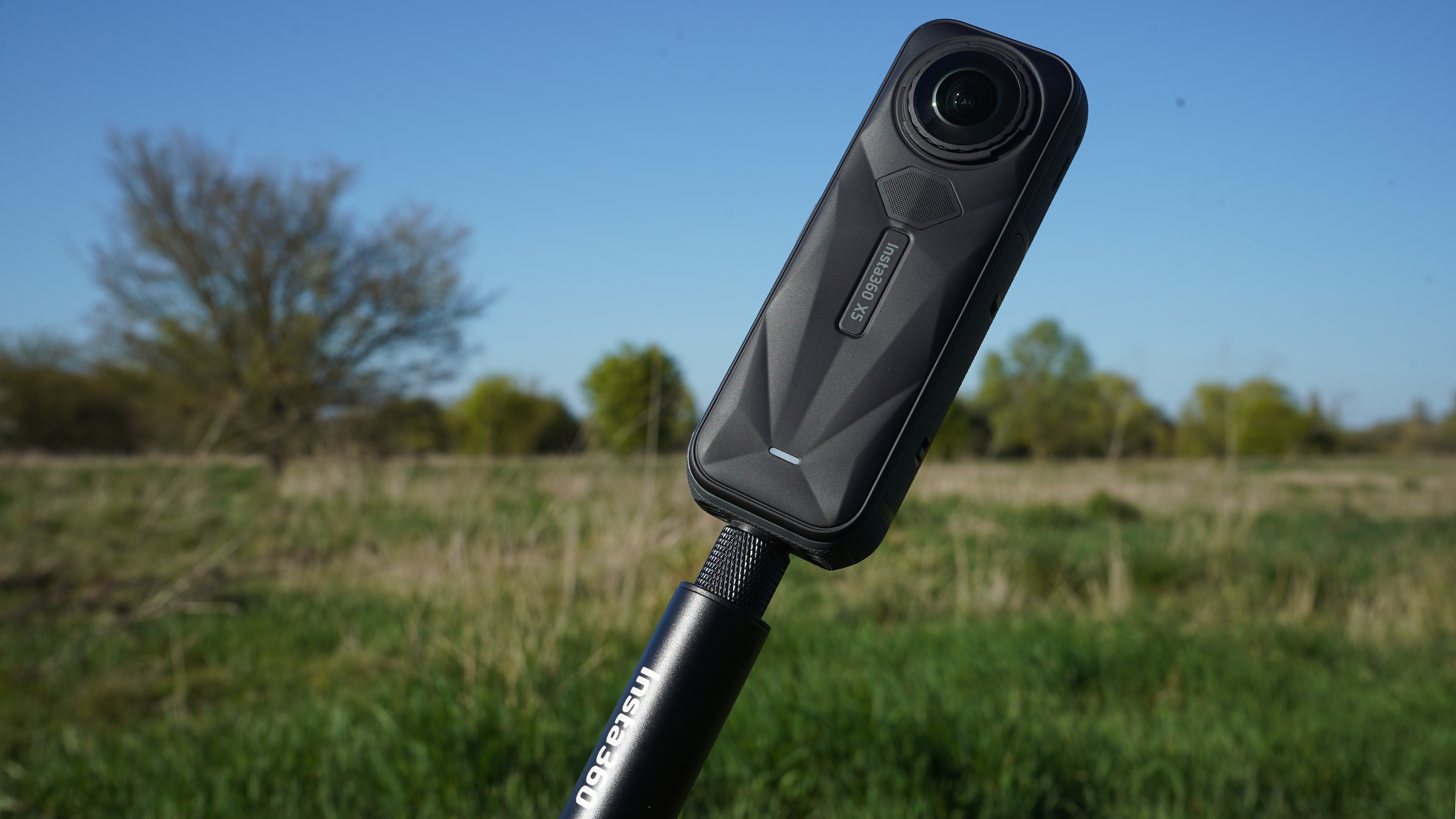Digital Camera World Verdict
With a design and a control layout that makes it closer in looks and handling to a consumer-level camcorder than a regular monocular, this is its maker’s most approachable and affordable thermal imaging solution we’ve tested to date. It’s compact enough to easily slip into a jacket pocket and weighs a point-and-shoot camera like 300g, meaning we’re more likely to take the Pulsar Axion XQ30 Pro out with us than chunkier and heavier devices from the same manufacturer. That said, there are some inevitable compromises when compared to bigger and more expensive alternatives. These include a lower resolution sensor and display, shorter detection range, lack of built-in laser rangefinder plus a smaller objective lens. The positives are that such development choices have resulted in a device that not only still works almost as well, but it’s more accessible and convenient with it.
Pros
- +
A good starter option for someone wanting or needing to detect subjects via heat signature alone
- +
An almost pocket sized degree of compactness aids portability and usability
- +
Fairly priced compared to other thermal imaging devices in the range
Cons
- -
Dual use buttons require a period of familiarisation and can prove a little fiddly
- -
Still expensive overall compared to a standard analogue monocular without any heat seeking capability
- -
No removable media port (an app is required to access and share images)
Why you can trust Digital Camera World
At one time, thermal imaging devices were reserved for use by security specialists or the military alone, but now such technology is in the hands of consumers and more affordable with it. That being said, devices including the Pulsar Axion XQ30 Pro thermal imaging monocular we’re examining here are still very much niche, specialist tools. Not everyone wants or needs to observe and identify their subject day or night by their heat signature alone – and so inevitably this thermal imaging monocular is priced at a premium compared with a standard analog monocular or binocular.
If it’s just being able to pick out subjects in the dark you’re after, there are also less expensive alternatives to be found in night vision goggles and scopes. But those don’t possess the ability to ‘see’ and identify skittish creatures via their heat signature, the advantage here being that we can pick out subjects even when they’re partially visually obscured by natural or man-made objects, such as fences, walls, or foliage. That’s a definite advantage.
And yes, while the Pulsar Axion XQ30 Pro thermal imaging monocular, indirectly replacing the previous Axion XM30F, won’t be for everyone, anyone who’s used a handheld camcorder should find its handling and operation familiar to a degree. Plus the price has been set at a level that still makes it one of the more affordable thermal spotting options out there. If a binocular is just too bulky and something compact that can be quickly slipped into or readily retrieved from a jacket pocket is what we are after, it looks like this rechargeable battery-powered thermal imaging monocular has a lot going for it.
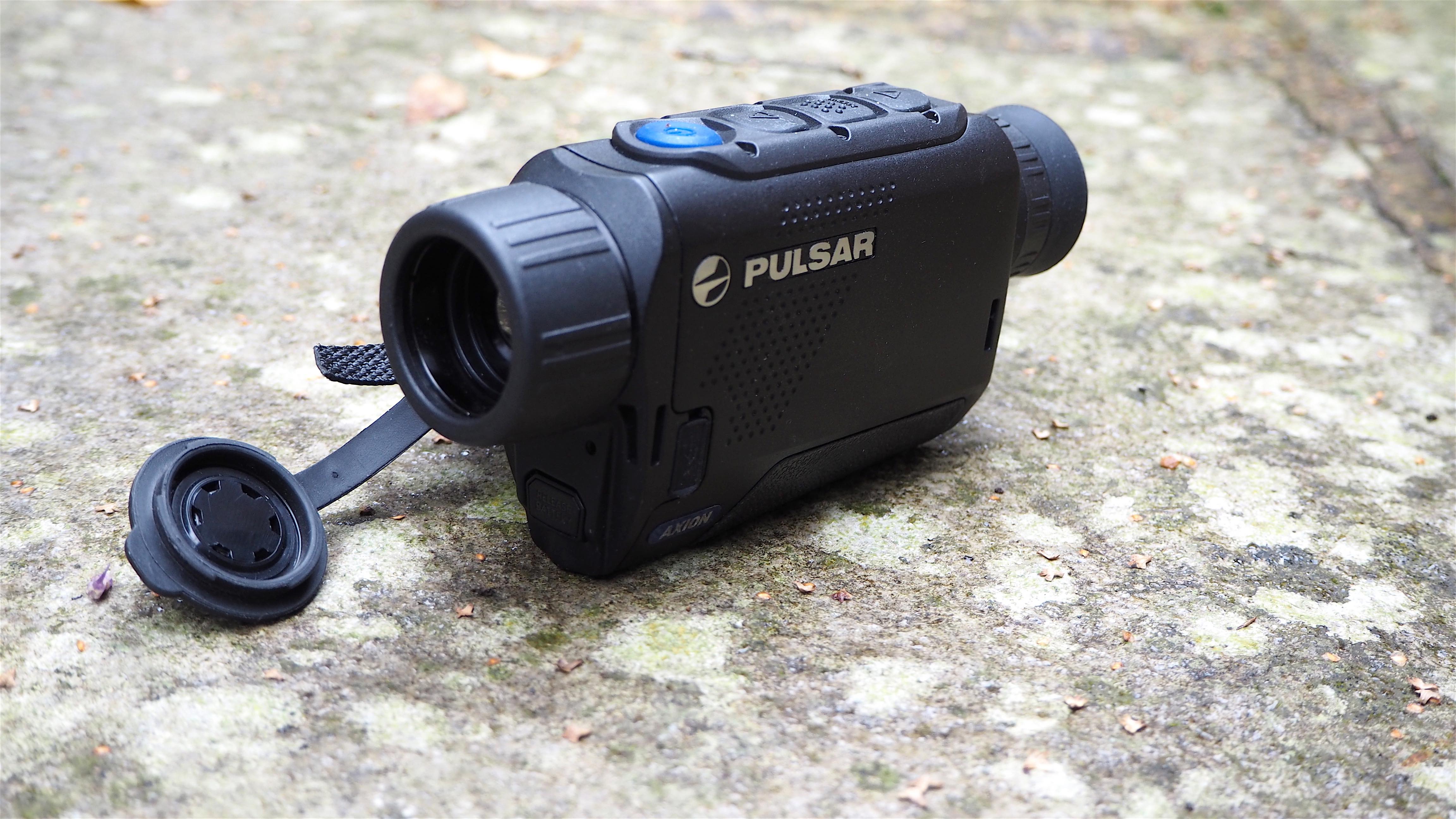
Pulsar Axion XQ30 Pro: Specifications
| Magnification | 2-8x |
| Objective lens | 30mm f/1.0 |
| Thermal sensor | 384x288 |
| Detection range | 1050m |
| Display | 640x400 AMOLED |
| Built-in memory | 16GB |
| Weight | 300g |
| Dimensions | 144 x 41 x 69 mm |
Pulsar Axion XQ30 Pro: Key Features
The claim here is that the Pulsar Axion XQ30 Pro thermal imaging monocular can pick out a heat signature at up to a distance of 1050m. Integral to its feature set is a 30mm objective lens with bright f/1.2 aperture, which is wedded to a 384x288 sensor. While that may in itself appear nothing much to write home about, in practice, it proves more than adequate. Magnification here ranges from a modest 2x to a boosted 8x, for when we need to get closer still. Of course, there’s the need to manually re-adjust focus via the stiff-to-the-touch focus wheel encircling the lens when we do, but the basics here at least feel familiar.
Also practical is an eight-hour battery life, which could see us through the night. While there is a standalone battery charger available for recharging the battery in use, none was provided with our review sample. Luckily then, the USB lead and mains plug we did find in the box is capable of doing the job when plugged directly into the USB port of the monocular itself. Keeping things streamlined, this is hidden beneath a rubber flap on the left-hand side of the device, if viewing it from the eyepiece/business end.

As with Pulsar’s other thermal imaging devices, there’s the ability to capture stills or video clips with a sequence of button presses, in lieu of any more obvious dedicated shutter release button. These are saved to a 16GB internal memory sufficient for potentially saving thousands of JPEG format snaps, or alternatively hours of 528x400 MPEG4 video. Getting them off the device for observing and sharing is a bit of a faff however, as there’s no option of inserting and retrieving a microSD or SD card. Instead, we first need to download a dedicated free-of-charge Stream Vision 2 app and then wirelessly pair the monocular with our smartphone. Once started it proves a straightforward enough process that also involves entering a user code to make the final connection between devices.

Once up and running and when observing subjects or taking images with an eye pressed up against the combined eyepiece and dioptre adjustment ring, there is a choice of eight color palettes. The thinking is that we might find one easier on the eye or able to provide a clearer more recognisable view than others in certain scenarios. Our particular favorite of ours here, which is also found on Pulsar’s other thermal imaging devices, is ‘Rainbow’, though the alternative ‘Ultramarine’ setting is equally recommended when seeking clarity as an aid for subject recognition and identification. Otherwise, the default setting appears to be the monochromatic ‘White Hot’ option when powering up this monocular for the first time. Alternatives are Black Hot, Red Hot, Red Monochrome, the more gentle-on-the-eye Sepia plus Violet.
However what’s missing on this particular model is the laser rangefinder found on bulkier and more expensive alternatives, such as Pulsar’s own Merger LRF XP35. A rangefinder can be useful for rapidly and more accurately measuring how far in meters our subject is from us.
But to be fair, as the Pulsar Axion XQ30 Pro feels more like an entry-level alternative in comparison – and so potential purchasers may not need or want the rangefinder facility – we can’t reasonably expect the full package at the price being asked.

Pulsar Axion XQ30 Pro: Design & Handling
More diminutive and lightweight than both the Pulsar Telos XQ35 monocular and Pulsar Merger XP35 binocular we’ve previously reviewed, the Pulsar Axion XQ30 Pro thermal imaging monocular sits comfortably held horizontally in the palm, in much the same way as a more compact model of camcorder would.
Despite the small overall size, there are large, chunky, and springy-to-the-touch operational rubber buttons laid out in a row along the top plate. These readily fall under the forefinger for easy reach and operation, the thumb naturally curving beneath the body to provide a means of handheld support. Diminutive dimensions also ensure this device is easier to slip into a jacket pocket and transport than either of the same brand alternatives mentioned above. This means that we’re potentially more likely to opt for this alternative as an ‘everyday’ option to have about our person, for as and when an observation scenario requiring its deployment arises.
Despite the smaller overall size and a more affordable price tag than the alternatives mentioned above, the quality of construction – a stamp on the bottom declares Latvian manufacture – doesn’t appear to have suffered, or corners have been overtly cut to meet this particular price point.
The feel of the magnesium alloy body shell is reassuringly solid, especially with the cylindrical rechargeable battery inserted, which, in lieu of a standalone mains charger this time, can be charged when inserted within the camera, thanks to the supplied USB cable and mains plug.
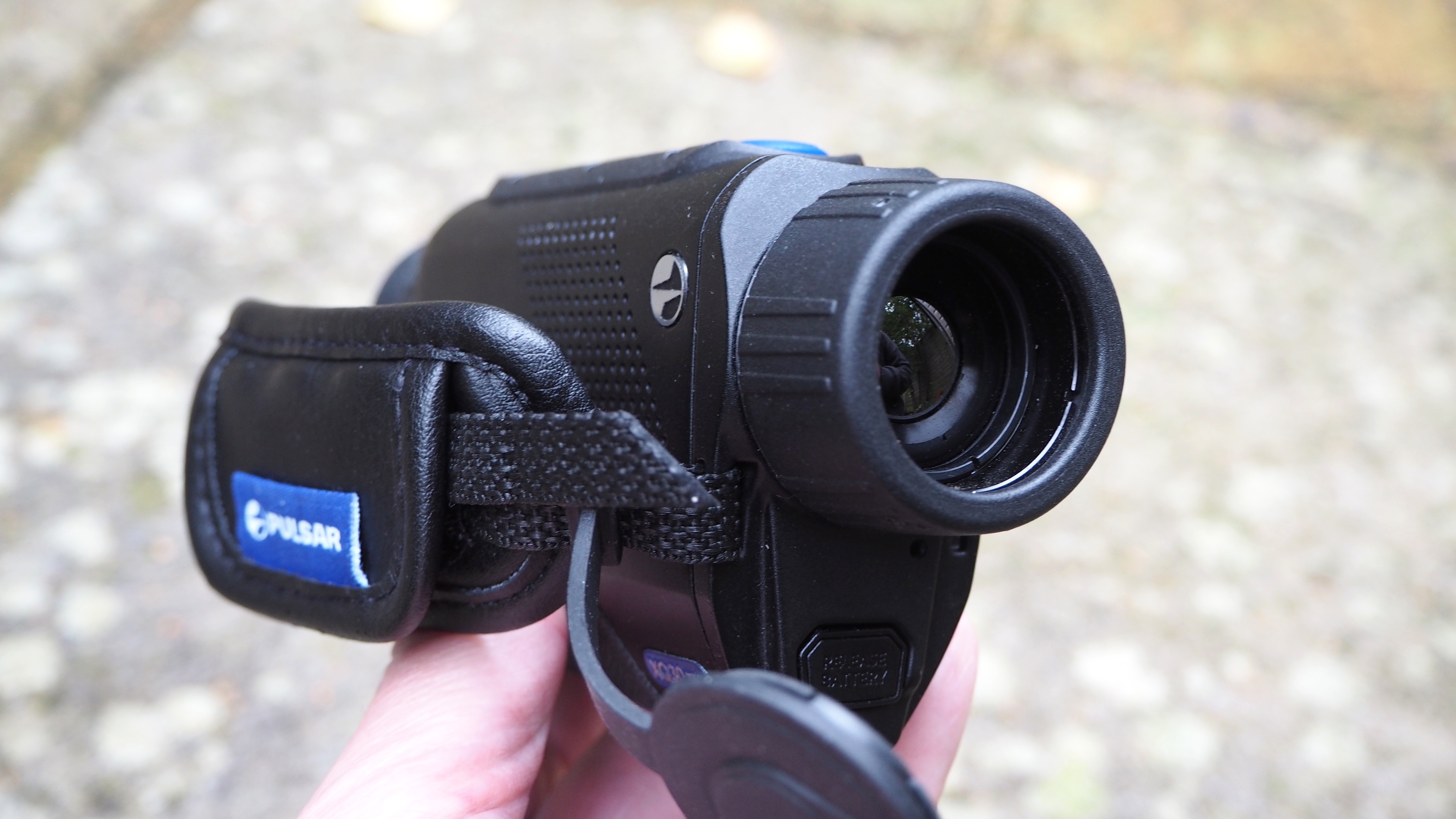
We were a little surprised that there is no external flap to cover the end of the battery once it’s been inserted, but then again, in the interests of space-saving, it isn’t uncommon for a camcorder to wear its battery on the outside. While there is a marker on this power cell to indicate which way up it should be inserted, we would have preferred some audible click to reassure us it had been inserted fully and correctly. Here we just slide it into place until it will go no further.
Its maker has provided a dedicated battery release button just under the front lens of the Pulsar Axion XQ30 Pro, but this control feels slightly superfluous as we can easily remove the battery from the base of the device just using the nail of our thumb. It’s a minor gripe for sure, but we’d have preferred it in terms of handling if the battery insertion felt a little more solid and a little less loose.
Despite being small enough to fit snugly in the palm, the Pulsar Axion XQ30 Pro does actually provide a screw thread at its base for potential tripod mounting should. Pairing this monocular with an equally pocket-sized travel tripod would be the obvious way to go if we were thinking of using it for extended periods of time, especially outdoors. Here some protection against the elements is provided courtesy of the device’s IPX7 waterproof rating, the same level of protection as Pulsar’s pricier Merger LRF XP35 thermal imaging binocular. This means in practical terms that it can potentially survive being dunked in water at a meter’s depth for 30 minutes, though given that it’s a simple rubber flap protecting the USB port, we wouldn’t actually want to risk that.

Pulsar Axion XQ30 Pro: Performance
As a default, the digital image relayed via the eyepiece/viewfinder of the Pulsar Axion XQ30 Pro is monochromatic, this visual resembling a low-resolution security camera or 1960s television transmission beamed through the ether to a cathode ray tube TV set. There are several other viewing settings as already detailed, however, with the ‘Rainbow’ setting providing a visual heat signature akin to the titular character’s view in Predator. Alternatively, the likes of Red Monochrome, give the heat signature of our subjects a fiery, Human Torch-like glow. Happily, you can play around and find what works for you.
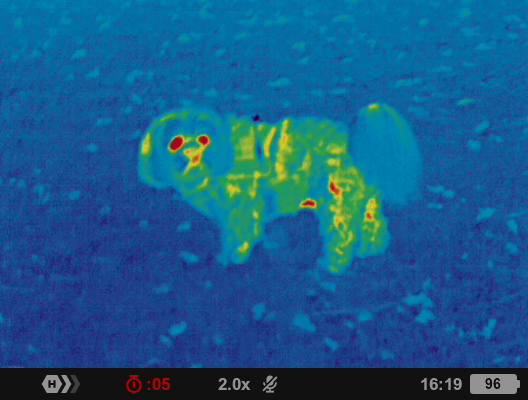

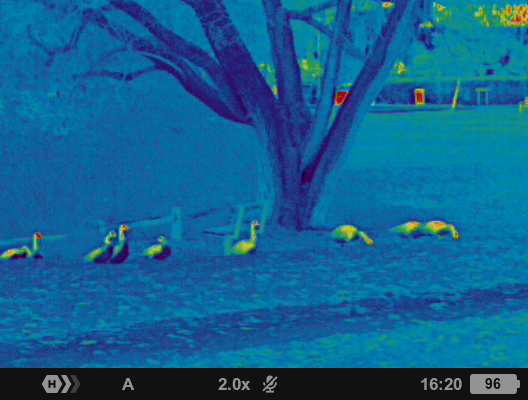
As well as merely observing, on this device, as with previously reviewed Pulsar models, there is the ability to take photos and video clips. These are stored within the monocular itself in lieu of any slot for removable media. As noted earlier we have a generous 16GB to play with here, which means we won’t be exhausting its data capacity anytime soon.
Although it’s not immediately obvious without recourse to the quick start manual provided in the box, we can switch between recording either stills or video with a long press of the ‘down’ button nearest to the eyepiece.

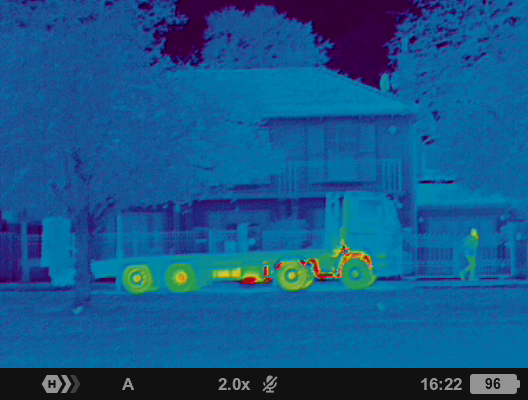
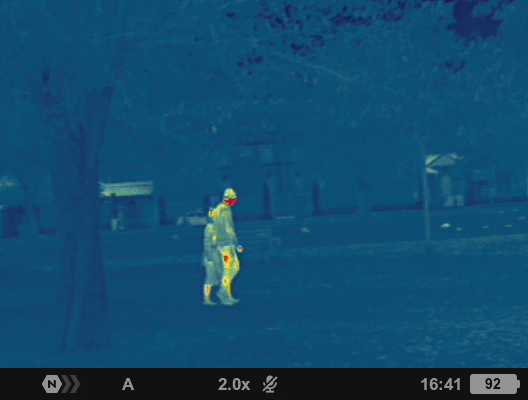
In fact, how long or how short we press down on each control in the minimalist four-button layout here provides differing operational results. So a brief period of familiarisation and yes, manual consultation, is required before we can get going in earnest with the Pulsar Axion XQ30 Pro. It’s a little fiddly at first, but we quickly got used to its quirks, and more importantly, the device does what it’s meant to – isolating subjects from distracting backgrounds due to their unique heat signatures. And not just for biological subjects; point this product at a moving car and you’ll also be able to spot the heat from its tires and engine.
Pulsar Axion XQ30 Pro: Verdict
Seeking a thermal imaging-equipped observation device without completely blowing the budget? While not inexpensive, the Pulsar Axion XQ30 Pro thermal imaging monocular is one of the more keenly affordable options out there given its feature set. Plus its miniature camcorder-like design and handling will feel more approachable for first-timers and the curious, not to mention conveniently portable with it.
Yes, there’s no built-in laser rangefinder this time around for those wishing to identify the distance between themselves and their visual quarry, but if you don’t mind that omission, this entry-level option in its maker’s lineup has a lot going for it. Recommended.
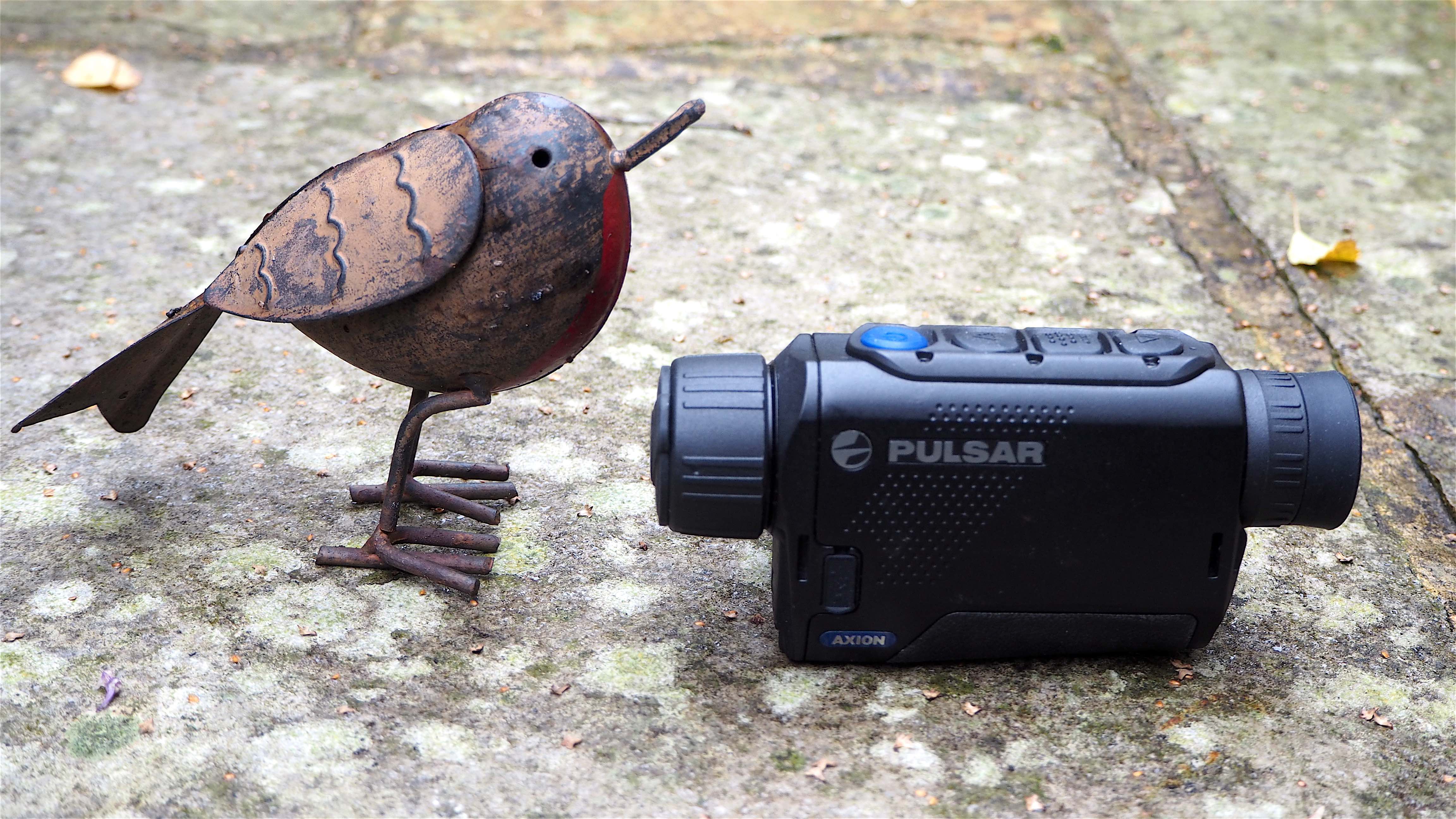
Alternatives
Though if it’s ‘just’ the ability to see in the dark and the dim we’re after and spot subjects we wouldn’t otherwise be able to see, there are more affordable solutions from brands including Bushnell, Bresser, Nightfox, and Solomark – though none of those are thermal imaging devices like the one here.
A couple of closer alternatives come in the shape and operation of Pulsar’s own Telos XQ35 thermal imaging monocular plus, if binoculars are more your thing, then also the thermal imaging equipped Pulsar Merger LRF XP35. Its ‘LRF’ letters denote that the latter is fitted with a laser rangefinder. That’s something we don’t get on the more affordable, smaller, and generally less well-specified Pulsar Axion XQ30 Pro, but having an LRF does command an additional price premium, so it’s swings and roundabouts.
The Merger LRF XP35 again offers a 16GB internal data capacity and a built-in zoom, in that particular case a broader 2x to 16x. It also betters the Axion XQ30 Pro on paper by providing a 640x480 thermal sensor, a more detailed 1024x768 AMOLED display, plus the bigger 35mm f/1.0 objective lens that partly gives the XP ‘35’ its name. Inevitably though, the Merger LRF XP35 is bulkier than the Axion, at a weight of 830g compared to 300g.
Sitting in between these two options is the same manufacturer’s Pulsar Telos XQ35 monocular at 570g. This also offers the marginally better 1024x768 AMOLED display and the 35mm f/1.0 objective lens, yet the same 384x288 thermal sensor as the Axion XQ30 Pro. This option is physically bigger and lens wieldy overall, however, so again something to take into consideration.
Gavin has over 30 years’ experience of writing about photography and television. He is currently the editor of British Photographic Industry News, and previously served as editor of Which Digital Camera and deputy editor of Total Digital Photography.
He has also written for a wide range of publications including T3, BBC Focus, Empire, NME, Radio Times, MacWorld, Computer Active, What Digital Camera and the Rough Guide books.
With his wealth of knowledge, Gavin is well placed to recognize great camera deals and recommend the best products in Digital Camera World’s buying guides. He also writes on a number of specialist subjects including binoculars and monoculars, spotting scopes, microscopes, trail cameras, action cameras, body cameras, filters and cameras straps.

